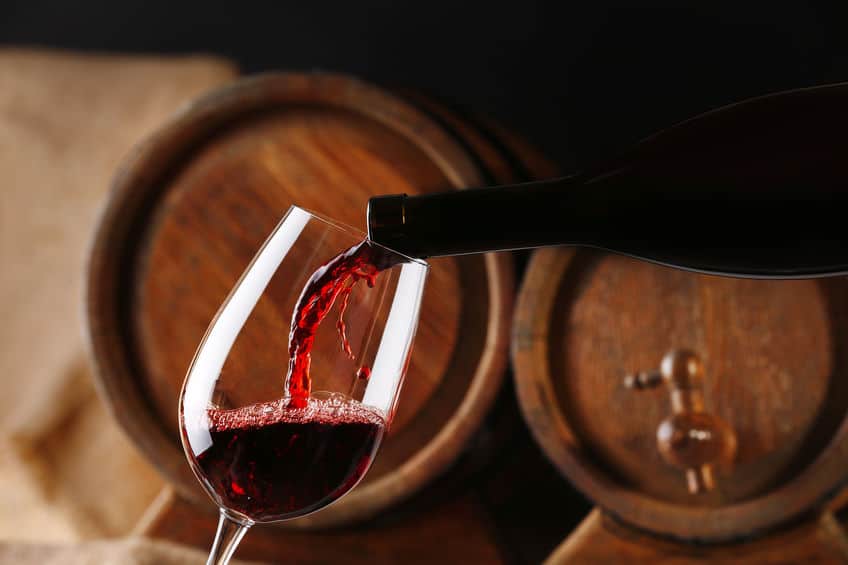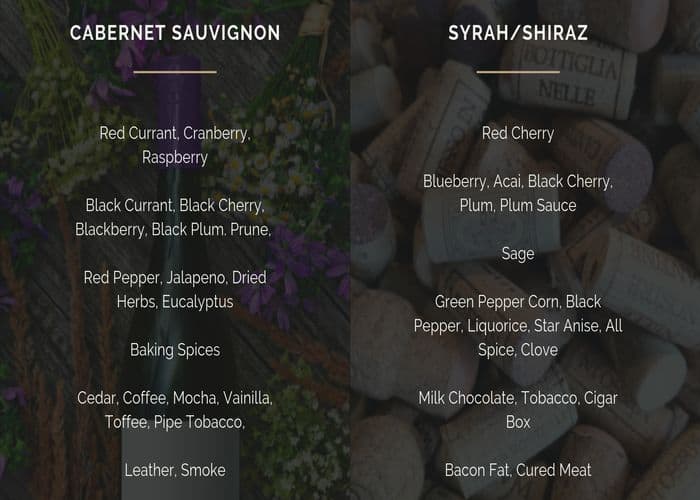Shiraz and Cabernet Sauvignon are some of the greatest grape varieties in the wine world. What are the actual facts that make them really different?
What is the difference between shiraz and cabernet? Even though they share many similarities, the main differences rely on four key facts:
- Different Berry Sizes Lead To Different Wine Texture And Structure.
- Cabernet Is More Widely Spread, And It Is Definitely More Popular
- Aromatic And Flavor Profile Can Actually Show Great Differences
- They Show Different Blending Affinity
Both varietals have thick skins, and produce bold wines full of character and flavors, with a great color. Because of their many similarities, even the most experienced wine professionals have a hard time telling the two apart in a blind tasting. But don’t worry. Below we’ve put together a simplified guide for you to become a Cabernet and Syrah expert in a nutshell.
Note: Syrah or Shiraz?
Shiraz and Syrah and are simply different names for the same grape variety. “Syrah” belongs to Rhône Valley in France and points more to an Old World–style. “Shiraz” is the Australian name for it, and it makes reference to a lush, rich and fruit-forward style.
Shiraz vs Cabernet
Even when there are many good reasons to find there similar, let’s explore the details of the real deal. What are the actual differences between Cabernet Sauvignon and Syrah?
1. DIFFERENT BERRY SIZES LEAD TO DIFFERENT WINE TEXTURE AND STRUCTURE.
Syrah berries are small to medium sized, and they have a thick skin with black color and purple tint. While Cabernet berries and bunches are smaller with a dark blue skin, and presenting a high ratio of pip to pulp.
While Syrah tends to have a smoother, rounded and fine grained texture, Cabernet Sauvignon appears more angular in the palate, with a more obvious and outstanding grain texture.
2. CABERNET IS MORE WIDELY SPREAD, AND IT IS DEFINITELY MORE POPULAR
There’s a lot more Cabernet in the market than Syrah. There are approximately 460,000 acres worldwide planted with of Syrah (186,000 hectares, while there are almost double amount of Cabernet Sauvignon planted: 840,000 acres (340,000 hectares). Then, it’s more likely that consumers are more familiar with Cabs, having better odds at selecting a good Cabernet over a good Syrah.
3. AROMATIC AND FLAVOR PROFILE CAN ACTUALLY SHOW GREAT DIFFERENCES
In the nose, these wines might show a high intensity of aromas and flavors. No surprise that some of the most indulgent and expensive wines of the world are made with these two grape varietals.
Being black fruit dominant and sharing tobacco notes, can make it tricky to differentiate by the dominant flavors, but in general, the aromatic profile of Cabernet tends to show a much greener and herbal perfume, while Syrah is known for its spicy profile.
Syrah appears in the world in two main noticeable styles:
1. Rhone style (cool climate). It shows characteristics of plum, olive and black pepper corn notes.
Chile
Elqui Valley produces Northern Rhone style Syrah with aromatics of violets, black pepper and grilled meat, along with a savory and mid-weight palate. San Antonio and coastal Casablanca produce a richer and more powerful style than Elqui, with more blackberry fruit.
Western Australia
Shiraz coming from Geographe are bold in flavor, but soft in texture, with cherry or red berry aromas. Sometimes they show as well notes of pepper and mint.
Argentina
Argentina’s high altitude and cold nights at the foothills of the Andes allows San Juan or Uco Valley to produce some outstanding Syrah. The Argentinian style offers a vivid acidity, with a spicy and mineral nose, and a bacon and smoky tones as well.
Several wineries in Columbia Valley in Washington State are now producing some worth trying Rhone style Syrah.
2. The more fruit forward style (warmer weather).
It is recognized by fruitier style, with notes of blackberry, blueberry, and sweet tobacco. This profile can be best found in:
California
California was once known for producing heavy, overripe, high alcohol fruit bombs. But not anymore. Nowadays, the new generation of winemakers is shifting this old paradigm aiming for fresh, vivid and terroir-driven Syrah.
South Australia
The Barossa and McLaren Vale regions of South Australia are the most famous regions for producing intense, powerful and bold red. The big flavors of these Shiraz have great affinity to American oak, although a recent trend to switch to French oak.
Barossa Shiraz is known for its cherry, plum and blackberry flavors with savory tannins.
McLaren Vale makes complex and full-bodied Shiraz. They tend to have a great color intensity, high alcohol, soft tannins and dark fruit flavors, with notes of spices, licorice and flowers.
The Clare Valley Shiraz is typically big with a broad structure. Notes of red currant and black berries can be found.
Coonawarra Shiraz has a lighter body and notes of cherries, spices and earthy flavors.
South Africa
The Mediterranean climate from the cape is much warmer than Rhône Valley and produces rich and well-structured wines, with ripe tannins and black fruit and plum notes.
ALSO, Cabernet Sauvignon is produced in two well differentiated styles:
Black fruit, black pepper and cocoa powder style coming from warmer areas. These wines tend to have higher alcohol, and to have much more concentration of much riper tannins. For example:
Central California
Californian Cabernet is known for its characteristic green flavors like bell pepper, eucalyptus and mint. Wines from Central Valley are more fruit-forward. They have more mellow tannins, rich dark fruit notes of blackberry and blueberry and as well as earth, coffee and cedar.
Australia
Southern Australia produces Cabernet Sauvignon in Barossa Valley, Clare Valley, and McLaren Valley. In West Australia, it is produced in Margaret River. Besides varietal wines, the grape is commonly blended with Shiraz, which heightens its juicy black fruit character and enhances its distinctive mint and eucalyptus flavors.
Argentina
In the entry level, Argentina produces a range of simple and easy to drink varietal wine, meant for every day drinking. On the higher end, Uco valley produces sophisticated and complex Cabs that can beautifully age for many years.
South Africa
South Africa produces both varietal and blended versions of Cabernet Sauvignon. While some wineries produce the traditional Bordeaux-style blend, others like to mix it with Syrah (Shiraz). Its aromatics develop black pepper and bell pepper notes, complemented by ripe black fruit.
Spain
In Spain, Cabernet Sauvignon is one of the most planted red grapes. Even though its sometimes blended with Tempranillo, in the Penedés, Ribera del Duero and Navarra Regions it is also made as a single varietal.
Red fruit, Mint and Green Pepper are typical for Cabernets coming from colder weather. For example:
France
In France, Bordeaux-produces the most age-worthy expressions of Cabernet Sauvignon. Most likely, you will mostly find it as a Blending component of the Left Bank.
This style offers a full-bodied wine with black currant and violet notes and cedar and cigar box. In colder vintages, Cabs can develop great flavors of black currant, licorice, and some slightly herbaceous notes.
Chile
In Chile’s coolest areas, with Oceanic or high altitude influence, Cabernet expresses with bright black fruit aromatics, and a more structured and tannic profile. As a blend, it can be found along with Merlot and Carmenere. In the entry level range, Chile offers a great value for money, with straightforward and fruity Cabs.
Northern Italy
Cabernet Sauvignon is also grown in Tuscany, producing sweet plum and cherry flavors. On its blend version, Super Tuscans show tobacco and cigar box notes.
Washington
Washington Cabernet Sauvignon is known for achieving the ripeness and sweet aromas of California grapes, with the elegance of the Old World style.
North California in the US
Napa Valley is recognized in the world by its rich character, ripe black-fruit notes, and sweet vanilla and chocolate flavors, from the American oak aging. The longer ripening season makes big wines with high alcohol and lower acidity. At the highest altitudes of Napa Valley, like Howell Mountain or Mt. Veeder, the colder weather adds complexity and depth to the Cabs grown there.
BLENDING AFFINITY
Syrah or Shiraz coming from all over the world can be most likely found as a single varietal, but there are a few small exceptions. In the Northern Rhone, sometimes it might be co-fermented with around 5% of Viognier.
In the Southern Rhone is typically blended with Grenache, Mouvedre, Carignan and/or Cinsault. In Provence or Australia, it can be also blended with Cabernet Sauvignon in a unique and distinctive style.
On the other hand, Cabernet Sauvignon is known to be one of the greatest blending components, and many winemaker’s around the globe use it as a core component for their best wines.
If you are looking for France’s best Cabernet Sauvignon, you should head to the Bordeaux Isle and look to the sub-regions of the Médoc, Graves, and gravelly areas within Côtes de Bourg and Blaye. Cabernet Sauvignon loved gravel soil from Bordeaux, but it most commonly comes in a blend form.
What do they have in common?
Many wine professionals and wine students get tricked by the similarities among these grapes. With the following points in mind, you will be a complete Cabernet and Syrah expert. This is what they have in common:
WEATHER AFFINITY
Cabernet Sauvignon and Syrah grapes appreciate moderate temperatures and sunny climates with warm summers with little rain or clouds to mature at their best. France, Italy and s Spain are the main producers from Syrah and Cabernet in the Old World. Also, Australia, the USA, Chile, South Africa and Argentina, have as well adopted these two varietals to the New World.
COLOR INTENSITY
Both varieties have thick skins and have great intensity of color and purple hues. In general terms, it would be fair to say that Syrah has slightly darker than Cabernet. The color of these wines tends to be quite opaque as well.
OAK USE
Syrah and Cabernet both have a great affinity with both American and French Oak. In the nose both tend to show a strong evidence of oak aging.
BIG STRUCTURE
Sunny warm climate lead to well ripe fruit, and high concentration of flavors and a big bold structure. Extended macerations and long fermentations are also common techniques for Syrah and Cabernet, favoring these wines’ strength and character.
ACIDITY
Both Syrah and Cabernet has medium to medium plus acidity.
TANNINS
Both wines have medium-high concentration of tannins
ALCOHOL CONTENT
Both Syrah and Cabernet has medium plus alcohol, somewhere between 13,5% and 14,5%. Syrah from warmer weather can even have over 15%
AGING POTENTIAL
Both wines have grate aging potential. Great Cabernet and Syrah bottles can age for as much as 20+ years and still improve their qualities.
Fun Facts about Cabs and shiraz
China is rapidly expanding into winemaking. With nine distinct regions spread all over the country, there is still no clearly defined style of Chinese Cabernet Sauvignon. Anyways, it is the most important variety in terms of plantings, accounting for about 70 %of China’s wine production
The most expensive Australian wine, Penfolds Grange Hermitage 1951 set the record when a wine collector bought it in an auction at MW Wines in Adelaide in 2004. The wine is a Shiraz -Cabernet Sauvignon with predominance of the first.
The most expensive red wine ever sold was a six-liter bottle of Cabernet from Napa Valley. It was sold in 2000 at the Napa Valley Wine Auction and hit the record-smashing price of $500,000.

